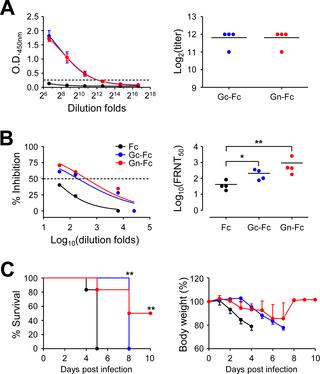当前位置:
X-MOL 学术
›
PLOS Negl. Trop. Dis.
›
论文详情
Our official English website, www.x-mol.net, welcomes your feedback! (Note: you will need to create a separate account there.)
Vaccination with single plasmid DNA encoding IL-12 and antigens of severe fever with thrombocytopenia syndrome virus elicits complete protection in IFNAR knockout mice.
PLOS Neglected Tropical Diseases ( IF 3.8 ) Pub Date : 2020-03-20 , DOI: 10.1371/journal.pntd.0007813 Jun-Gu Kang 1, 2 , Kyeongseok Jeon 1, 2 , Hooncheol Choi 1, 2 , Yuri Kim 1, 2 , Hong-Il Kim 1, 2 , Hyo-Jin Ro 1, 2 , Yong Bok Seo 3 , Jua Shin 3 , Junho Chung 4 , Yoon Kyung Jeon 5 , Yang Soo Kim 6 , Keun Hwa Lee 7 , Nam-Hyuk Cho 1, 2, 8
PLOS Neglected Tropical Diseases ( IF 3.8 ) Pub Date : 2020-03-20 , DOI: 10.1371/journal.pntd.0007813 Jun-Gu Kang 1, 2 , Kyeongseok Jeon 1, 2 , Hooncheol Choi 1, 2 , Yuri Kim 1, 2 , Hong-Il Kim 1, 2 , Hyo-Jin Ro 1, 2 , Yong Bok Seo 3 , Jua Shin 3 , Junho Chung 4 , Yoon Kyung Jeon 5 , Yang Soo Kim 6 , Keun Hwa Lee 7 , Nam-Hyuk Cho 1, 2, 8
Affiliation

|
Severe fever with thrombocytopenia syndrome (SFTS) is an emerging tick-borne disease caused by SFTS virus (SFTSV) infection. Despite a gradual increase of SFTS cases and high mortality in endemic regions, no specific viral therapy nor vaccine is available. Here, we developed a single recombinant plasmid DNA encoding SFTSV genes, Gn and Gc together with NP-NS fusion antigen, as a vaccine candidate. The viral antigens were fused with Fms-like tyrosine kinase-3 ligand (Flt3L) and IL-12 gene was incorporated into the plasmid to enhance cell-mediated immunity. Vaccination with the DNA provides complete protection of IFNAR KO mice upon lethal SFTSV challenge, whereas immunization with a plasmid without IL-12 gene resulted in partial protection. Since we failed to detect antibodies against surface glycoproteins, Gn and Gc, in the immunized mice, antigen-specific cellular immunity, as confirmed by enhanced antigen-specific T cell responses, might play major role in protection. Finally, we evaluated the degree of protective immunity provided by protein immunization of the individual glycoprotein, Gn or Gc. Although both protein antigens induced a significant level of neutralizing activity against SFTSV, Gn vaccination resulted in relatively higher neutralizing activity and better protection than Gc vaccination. However, both antigens failed to provide complete protection. Given that DNA vaccines have failed to induce sufficient immunogenicity in human trials when compared to protein vaccines, optimal combinations of DNA and protein elements, proper selection of target antigens, and incorporation of efficient adjuvant, need to be further investigated for SFTSV vaccine development.
中文翻译:

用编码IL-12的单一质粒DNA和血小板减少症候群病毒的严重发热抗原进行疫苗接种可在IFNAR基因敲除小鼠中获得完全保护。
血小板减少症候群(SFTS)的严重发烧是由SFTS病毒(SFTSV)感染引起的新兴tick传播疾病。尽管SFTS病例数逐渐增加并且在流行地区死亡率较高,但尚无特定的病毒疗法或疫苗可用。在这里,我们开发了一个编码SFTSV基因,Gn和Gc以及NP-NS融合抗原的重组质粒DNA,作为候选疫苗。将病毒抗原与Fms样酪氨酸激酶3配体(Flt3L)融合,并将IL-12基因掺入质粒以增强细胞介导的免疫力。用DNA疫苗接种可在致命的SFTSV攻击后对IFNAR KO小鼠提供完全保护,而用不含IL-12基因的质粒进行免疫则可部分保护。由于我们未能在免疫小鼠中检测到针对表面糖蛋白Gn和Gc的抗体,如增强的抗原特异性T细胞反应所证实的,抗原特异性细胞免疫可能在保护中起主要作用。最后,我们评估了单个糖蛋白,Gn或Gc的蛋白质免疫所提供的保护性免疫的程度。尽管两种蛋白抗原均诱导了针对SFTSV的显着水平的中和活性,但Gn疫苗接种比Gc疫苗接种具有相对更高的中和活性和更好的保护作用。但是,两种抗原均不能提供完全的保护。鉴于与蛋白质疫苗相比,DNA疫苗在人体试验中未能诱导足够的免疫原性,因此,对于SFTSV疫苗开发,需要进一步研究DNA和蛋白质元素的最佳组合,正确选择靶抗原以及掺入有效佐剂。
更新日期:2020-03-21
中文翻译:

用编码IL-12的单一质粒DNA和血小板减少症候群病毒的严重发热抗原进行疫苗接种可在IFNAR基因敲除小鼠中获得完全保护。
血小板减少症候群(SFTS)的严重发烧是由SFTS病毒(SFTSV)感染引起的新兴tick传播疾病。尽管SFTS病例数逐渐增加并且在流行地区死亡率较高,但尚无特定的病毒疗法或疫苗可用。在这里,我们开发了一个编码SFTSV基因,Gn和Gc以及NP-NS融合抗原的重组质粒DNA,作为候选疫苗。将病毒抗原与Fms样酪氨酸激酶3配体(Flt3L)融合,并将IL-12基因掺入质粒以增强细胞介导的免疫力。用DNA疫苗接种可在致命的SFTSV攻击后对IFNAR KO小鼠提供完全保护,而用不含IL-12基因的质粒进行免疫则可部分保护。由于我们未能在免疫小鼠中检测到针对表面糖蛋白Gn和Gc的抗体,如增强的抗原特异性T细胞反应所证实的,抗原特异性细胞免疫可能在保护中起主要作用。最后,我们评估了单个糖蛋白,Gn或Gc的蛋白质免疫所提供的保护性免疫的程度。尽管两种蛋白抗原均诱导了针对SFTSV的显着水平的中和活性,但Gn疫苗接种比Gc疫苗接种具有相对更高的中和活性和更好的保护作用。但是,两种抗原均不能提供完全的保护。鉴于与蛋白质疫苗相比,DNA疫苗在人体试验中未能诱导足够的免疫原性,因此,对于SFTSV疫苗开发,需要进一步研究DNA和蛋白质元素的最佳组合,正确选择靶抗原以及掺入有效佐剂。



























 京公网安备 11010802027423号
京公网安备 11010802027423号